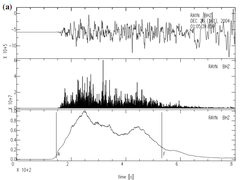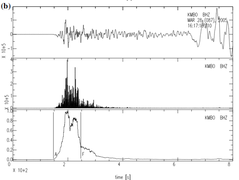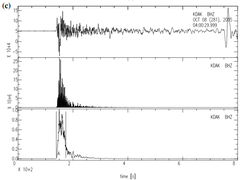Calculate source duration
Contents
The duration of strong earthquake ground motion is one of the main parameters characterizing this natural phenomenon.
In Kanarnori and Anderson (1975)1, faulting duration is defined as
where $t$, $L$ and $v$ are duration of faulting, fault dimension and average propagation velocity, respectively. It’s hardly possible to obtain faulting duration by measuring fault dimension and propagation velocity. However, source duration can be attained from source time function or the envelope of waveforms [e.g., Bilek et al., 20042; Hara, 20073]. Here are examples from Hara (2007)3, “A” and “F” in the bottom traces denote arrivals of P-waves and estimated ends of high frequency energy radiation.



Our method to estimate source duration is back-projection technique. I have written basic BP manual in the blog, and mentioned source duration in Section 8. On this basis, next I’m going to calculte exact source duration rather than roughly estimate from energy-time plot.
Trap skip…
-
Kanamori H, Anderson D L. (1975), Theoretical basis of some empirical relations in seismology[J]. Bull.seism.soc.am, 65(5):1073-1095. ↩︎
-
Bilek, S. L., T. Lay, and L. J. Ruff (2004), Radiated seismic energy and earthquake source duration variations from teleseismic source time functions for shallow subduction zone thrust earthquakes, J. Geophys. Res., 109, B09308, doi:10.1029/2004JB003039. ↩︎
-
Hara, T. (2007), Measurement of the duration of high-frequency energy radiation and its application to determination of the magnitudes of large shallow earthquakes, Earth Planets Space, 59(4), 227–231. ↩︎
Author Qiang
LastMod 2018-07-16